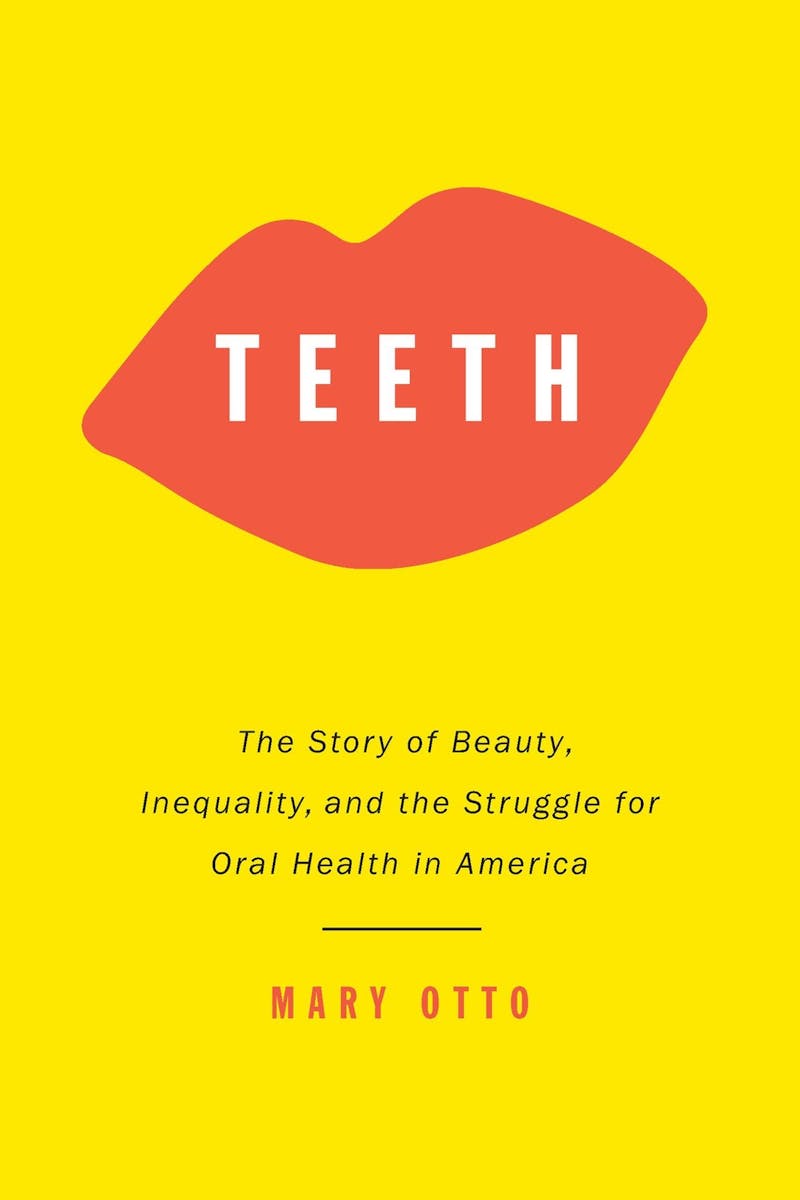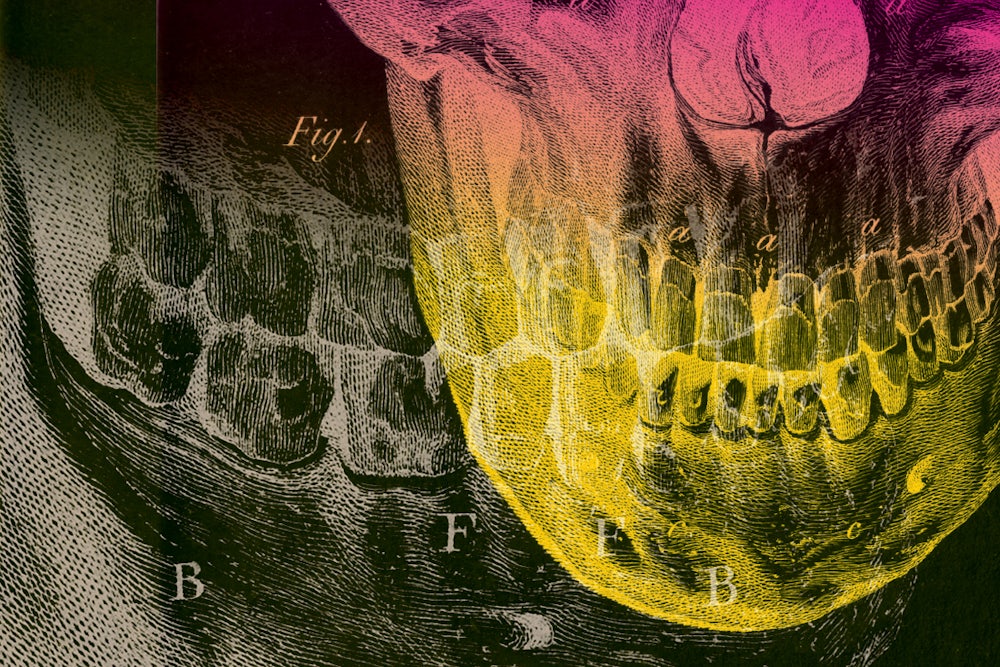That our teeth are in our heads seems natural, though the location is something of a liability. The trouble starts with tooth decay, which permits the usually harmless bacteria in our mouths to enter the spongy, supportive core of the tooth (the “pulp”). Something untoward can then unfold. The germs proliferate, white blood cells amass, pus accumulates, and a dental abscess is born. Hence the liability: It’s not good to have all this happening so close to one’s brain.
An untreated dental abscess can invade the tissues of the head and chest. It can infect and clot the veins of the neck, and spread between the skull’s many sinuses. If it reaches the brain, it can result in a brain abscess or meningitis. This is now a rare event, but it wasn’t always. In the seventeenth century, “ ‘teeth’ were continually listed as the fifth or sixth leading cause of death,” a 1999 article in the Journal of the History of Dentistry asserts. Two hundred years ago, the author notes, tooth pain was a killer.

But here’s an unfortunate rule in medical history, at least in the United States: The untreatable conditions of the past become the untreated tragedies of the present. Mary Otto’s heartrending and incisive book, Teeth, builds on her Washington Post story on Deamonte Driver, a black twelve-year-old from Maryland who “died of a toothache” in 2007. His life could have been saved, she wrote, if his family had insurance, or if they had not been stripped of Medicaid for a time when they were homeless, or if Maryland’s underfunded Medicaid program had provided adequate access to dentists. “By the time Deamonte’s own aching tooth got any attention,” Otto reported, “the bacteria from the abscess had spread to his brain.” Surgeries and no doubt much suffering followed, but it was too late.
Deamonte Driver’s death was the direct result of a system of commoditized dental care. Some 114 million people lack any sort of dental coverage in the United States, and about half of children on Medicaid did not receive a single dental service in 2012. We could implement a system of universal coverage that would make treatment available on the basis of health needs, not means. But we have not. As Otto traces the history of modern dentistry, from eighteenth-century surgical experiments to the founding of the first American school of dentistry in 1840, she explains how the United States instead developed a “carefully guarded, largely private system,” one that is “enormously difficult to reach for those without mobility or money.” The state of our teeth, she argues, reveals—and reinforces—deep inequalities in society.
The story of our privatized dental system runs parallel to the more familiar story of America’s health care system. Over the past century or so, right-wing political forces have again and again impeded efforts to create some sort of national health insurance system. In the early postwar era, when many countries in Europe were creating or expanding systems of national health care, a health insurance plan proposed by President Truman was famously sunk by a vitriolic campaign of red-baiting, spearheaded by the American Medical Association—a historical episode Monte M. Poen relates in his book Harry S. Truman Versus the Medical Lobby. “Would socialized medicine lead to socialization of other phases of American life?” an AMA pamphlet asked in the late 1940s. “Lenin thought so,” it groundlessly answered.
The American Dental Association opposed dental care reform with equal vigor. Otto quotes ADA leaders who went to Washington to testify against the Wagner-Murray-Dingell Bill before the Senate Committee on Education and Labor in 1946: “Because of the limited number of dentists,” they argued, “it is impossible to carry out any program that promises complete dental care to both children and adults.” What these medical professionals lacked in compassion, they at least balanced with frankness: They were effectively admitting that much of the nation should be allowed to have their teeth rot. At the same time, the ADA and other dentists’ groups, then and now, have fervently opposed the expanded use of auxiliary dental professionals—mainly dental hygienists—to shore up the gap in care.
The victims of the profession’s obstruction are exactly who you would expect: the poor and—disproportionately—racial minorities. In her impressively wide-ranging reporting, Otto describes firsthand the effects of dental deprivation on impoverished indigenous communities in Alaska and impoverished white ones in Appalachia. She visits the town of Jonesville in Virginia, a municipality so neglected that a nonprofit known for delivering medical care to remote communities in the developing world decided it needed humanitarian assistance.
The whole town, it seems, shows up to the new clinic to have teeth yanked out. Otto speaks to a disabled miner who lost his dental insurance when he was no longer able to work. He seems to be on the verge of losing a leg, and only recently managed to pay off $1,500 in dental debt for three tooth extractions. Now he shows up to have a fourth tooth pulled. “I’m a good person,” he tells Otto, “but I sure have been tested.” He is in better shape, however, than one woman Otto meets waiting in line before sunrise outside a clinic in Maryland. She is looking to have no less than eleven teeth pulled. The woman, Otto says, has been slitting her own infected gums to “relieve the excruciating pressure.”
And while economic inequality—whether through poor diet or lack of access to dental services—can result in dental inequality, bad teeth also reinforce economic disadvantage. Work in heavy industry may, for instance, require a strong hand, but the service worker of today increasingly needs a sweet smile. Service workers are expected to perform what sociologist Arlie Russell Hochschild has termed “emotional labor” in their jobs, transmitting happiness to the consumer—a task that demands a degree of oral health. At a time when service jobs are the predominant working-class occupation, missing teeth make it harder to get hired. Toothlessness spells joblessness, which means lack of access to dental care, which in turn leads to more suffering.
Can dentistry be decommodified? Of course it can. To some extent or another, it already has been in other countries. The United Kingdom’s National Health Service—implemented in 1948, just as Truman’s national health insurance plan collapsed—included access to dental care, which was initially free at point of use. When fees for dental care were introduced a few years later, the Labor health minister, Aneurin Bevan, resigned in protest. While America’s private dental industry makes it difficult to institute universal care, the option remains the only salve for our country’s dental inequality.
Some may counter that universal coverage would lower quality. That’s simply not true of NHS dentistry, even despite the cuts and privatization it has suffered in recent decades. A 2015 study published in the British Medical Journal, titled “Austin Powers Bites Back,” found that England enjoyed dental health that was, overall, as good as America’s. Americans actually had more missing teeth than the English, but scored somewhat better on an oral health survey. At the same time, the study noted that “there are consistently wider educational and income-related oral health inequalities in the United States compared with England.” In short, tooth problems in America disproportionately affect the poor.
While socialized dental care may seem a long way off in our political moment, Otto’s book sympathetically explores a range of ideas for improving the current system. She describes efforts to expand the use of auxiliary dental professionals in neglected areas of the country, sending dental hygienists or “dental health aide therapists” to do tooth cleanings and other routine sorts of dental work. She notes how dentists could take a more preventive—and less surgical—approach. And she details attempts to expand access to dental services for those using Medicaid.
Although there is a lot of sense in such suggestions, they would not completely alleviate the current crisis. No doubt non-dentist dental professionals could be more widely employed, but a system in which the well-off see dentists and the poor see dental professionals with lower levels of training would be fundamentally inequitable. And no amount of prevention—not even the reduction of socioeconomic inequality itself—would eliminate the need for dental care, any more than it would eliminate the need for the care of cancer or heart disease. Another world is possible, as the leftist slogan goes, but that world would still need universal dental coverage.
We have, of course, known this for decades. In 1943, Harper’s profiled a left-wing dentist named Maurice William who wound up having a profound impact on the political philosophy of Sun Yat-sen. Raised by Russian immigrants in Brooklyn, William was a fierce socialist from a young age. He had entered law school, but his legal studies increasingly seemed inconsistent with his political ideals. One day, he visited his dentist—who, as it happened, was himself a socialist—to have a tooth pulled, and a serious conversation about William’s future ensued.
“I can’t see any purpose in my going to college, in all my studies,” William pondered aloud. “What can an honest socialist do in this world?”
“Become a dentist, comrade,” his dentist responded. “Under the most perfect system of society there will still be rotten teeth.”
